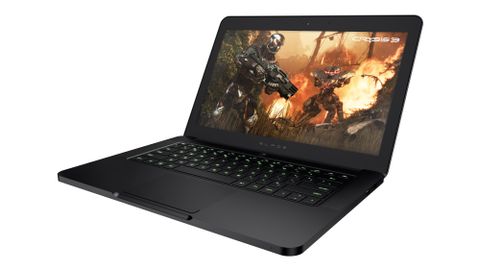Why you can trust TechRadar
At the end of the day, a gaming laptop is measured by three key elements, in this order: its gaming performance, its portability, and its suitability for general computing productivity. Then there's cooling, a ubiquitous underlying concern that both affects and is affected by cost. Very few PC laptops master each of these elements, and this isn't even considering other intangibles like aesthetic design, input controls, and more.
Okay, let's start grading out the Razer Blade.
We Liked
In the favorable category, we liked pretty much everything we saw, touched, and played with. Performance? Check. Looks? Check? Slim profile? Yes. Next-gen components? Got it.
In fact, with just a few exceptions (which we'll get into shortly), this is a very well thought-out and designed system, both for gaming and day-to-day usage. Even the keyboard, which can be hit or miss on laptops, is comfortable and responsive for both games and productivity. And we love that it's backlit in a non-gaudy manner.
The screen also bears a second mention. Even though it's only 1600x900, the display is everything a laptop display should be. It's sharp and bright, with vibrant color reproduction.
It also bears mentioning that we appreciate the lack of bloatware on this system. Far too many systems—particularly those shipped by big PC OEMs—are loaded with all kinds of apps and utilities we neither want nor need. It's refreshing to start up a laptop for the first time and see none of this. In and of itself, this is a sign that you're in the right place.
Most of all though, we like the direction Razer is heading with this series of laptops. Walking the line between performance, power consumption, and thermal dynamics isn't easy, but Razer is doing it quite well.
The fact that this laptop is so thin, lightweight, and aesthetically pleasing is more than a bonus; it puts the Razer Blade in rarified company.
We disliked
The biggest gripe we have with this laptop is far and away the mouse touchpad. The left and right mouse buttons at the bottom of the touchpad are flat-out uncomfortable to use. Thankfully, you can just tap the pad itself to left-click, but you have no such recourse for accessing context sensitive menus via right-clicking. A clickable touchpad with a bottom right-hand corner that functioned as the right mouse button—like that found on the MacBook series—would be infinitely preferable.
Button placement and responsiveness can be subjective. Annoying trackpad glitches typically are not. Far and away, the most dislikable feature here is the touchpad's inconsistent sensitivity. At least once every half hour, we experienced the odd glitch mentioned previously that caused the cursor to ghost jump the cursor to another line of text while we were typing.
This feels like a bit more than a minor bug or annoyance; at the wrong moment, it can be infuriating. Thankfully, it didn't happen to us often enough to drive us over the ledge. It's not a deal breaker, but we're hoping it's some kind of temporary bug that gets fixed in a driver update. For what it's worth, we didn't see this error in the trackpad in the Razer Blade Pro we reviewed at the end of 2012.
The only other significant gripe that we have is the Razer Blade's 1600 x 900 display resolution, and even this is more theoretical than anything. Sure, a full 1080 HD display would have been nice, and a Retina Display-style 2560 x 1600 screen would have been amazing, mostly because it makes multi-tasking and working much easier to do. But again, it's not a deal breaker—particularly given the high quality of the existing screen.
The final concern we have is the Razer Blade's price. $2,000 isn't cheap, but at least for that much money, you're getting state-of-the-art components and a great looking laptop.
Final Verdict
Ultimately and despite these few concerns, the Razer Blade sets a new high mark for what a mid-size Windows laptop can and should be. It looks fantastic, exhibits top-notch performance in both day-to-day use and gaming. And it's comfortable to work on.
In fact, it's no exaggeration to say that, with the two exceptions noted above—screen resolution and trackpad—the Razer Blade gives Apple's MacBook Pro line a serious run for the money.
In terms of performance, very few laptops of this shape and size are capable of rivaling what Razer has created. Even Apple's highest-end laptop—the 15-inch MacBook Pro with Retina Display—only has an Nvidia GeForce GT 650M as its dedicated graphics unit.
With all this in mind, we happily recommend the Razer Blade as an ideal gaming/work/road laptop.
One final note: It's worth mentioning that PC gaming laptops are experiencing an impressive renaissance right now. Ever since Windows 8 released at the end of 2012, we've seen a series of pretty amazing systems come across our desks.
This is definitely a trend worth watching.

